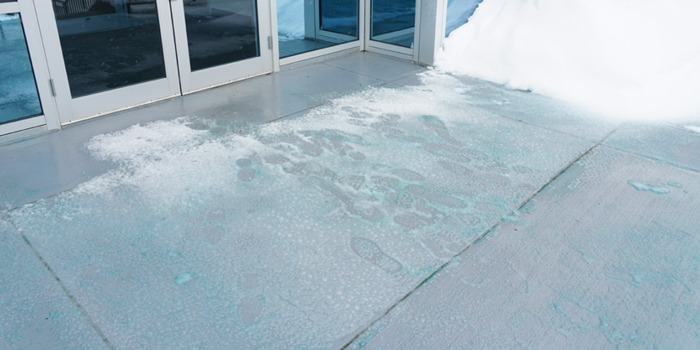- Home
- Loss Control
- Loss Control Insights
- Prevent winter slips: Smart ways to use ice melt
Slips and falls are one of the most common winter accidents—and one of the most expensive. According to EMC loss data, the average cost of a slip and fall injury is more than $12,000. The good news? You can reduce that risk for less than $20 a bag with one simple product: Ice melt.
Before sprinkling it on your sidewalks or parking lots, here’s what to know about how to use ice melt safely and effectively.
What is ice melt?
Ice melt is a chemical product designed to lower the freezing point of water, breaking the bond between ice and pavement. When used correctly, it helps keep walkways, steps, and parking areas clear and safe—reducing the chance of slips and falls.
There are several types of ice melt, and each has its pros, cons, and best-use scenarios:
| Chemical name | Temperature rating | Pros | Cons | Cost |
|---|---|---|---|---|
| Sodium chloride (rock salt) | 20°F | Quick to work; provides traction | Corrosive; harmful to plants and animals | $ |
| Potassium chloride | 12°F | Less corrosive to concrete/asphalt | Works slowly; harmful to plants in high concentrations | $$$ |
| Magnesium chloride | 0°F | Fast-acting; better for the environment; safer for plants/animals | Requires more product for same effect | $$ |
| Calcium chloride | -25°F | Quick, long-lasting; effective at very low temps | Can irritate skin and harm vegetation | $$$$ |
| Blends | Varies | Combines benefits of multiple types | Depends on mix | Varies |
Many businesses keep more than one type on hand—for example, using rock salt in early winter and switching to a magnesium or calcium chloride blend when temperatures drop.
How to apply ice melt
Always follow the directions on the packaging before applying. Some types (like calcium or magnesium chloride) require protective gloves, and anyone spreading ice melt outdoors should wear sturdy footwear or ice cleats for traction.
When spreading, less is more. Overusing ice melt doesn’t make ice melt faster — it just creates waste and can lead to corrosion or indoor residue. Instead of using a scoop or shovel, use:
- A handheld fertilizer spreader for small areas, or
- A walk-behind spreader for larger spaces
If possible, choose a product that’s tinted or dyed—the color helps you see where you’ve already applied it and prevents overuse.
How much ice melt to use
A general guideline is about half-cup per square yard, but always double-check the product label. Application rates vary depending on the chemical composition and temperature range.
Using too much not only wastes product but can also harm plants, pollute runoff water, and damage flooring when tracked indoors.
When to put ice melt down
Timing matters as much as the product itself. For best results, apply ice melt before precipitation freezes or immediately after snow is cleared. This helps prevent ice from bonding to the surface and makes shoveling easier later.
After ice melt has done its job, sweep up any leftover ice melt pellets from walkways, as the pellets themselves can create a slip hazard when on dry concrete.
Pro tip: Apply a commercial-grade concrete sealant to help prevent moisture from seeping into cracks where ice melt is regularly used.
How long does it take for ice melt to work?
Most ice melts begin working within 15–30 minutes, though it depends on the temperature and the type of product.
- Calcium chloride and magnesium chloride work fastest, even in subzero conditions
- Rock salt (sodium chloride) takes longer and becomes less effective below 20°F
If the product seems slow to activate, lightly break up the top ice layer with a shovel—this helps the chemical penetrate and start melting faster.
When to put out ice melt (and when not to)
It’s tempting to apply ice melt frequently during a storm, but more isn’t better. Reapply only as needed when you see new accumulation or slick areas forming.
Avoid these common mistakes:
- Don’t apply ice melt to new concrete (less than a year old); The chemicals can damage uncured surfaces
- Don’t dump melted slush onto landscaping, drains, or near waterways—the runoff can harm vegetation and wildlife
- Don’t track ice melt indoors—use sturdy scraper mats outside and absorbent wiper mats inside entryways; Clean and rotate them throughout the day to keep floors dry and safe
Storing ice melt properly
Ice melt is hygroscopic—it absorbs moisture from the air. To keep it from clumping or losing strength, store it:
- In a sealed, airtight container
- Away from sunlight, air, and moisture
- Off the ground and out of reach of pets
Proper storage ensures your ice melt stays effective all winter long.
Keep safety on solid ground
Using ice melt correctly is one of the easiest and most affordable ways to help prevent winter slip and fall injuries. Combine it with good snow removal practices and clear signage to keep your property safe for everyone.
For more slip and fall prevention resources, explore EMC’s Winter Slip and Fall Prevention Program and additional safety topics on emcinsurance.com.
Get in touch
Need help? We’re here for you! Whether you have questions or need personalized assistance, your local office is ready to support you.
Loss Control Insights
Stay informed with the latest news and receive actionable safety tips, all carefully curated by our team of experts.
